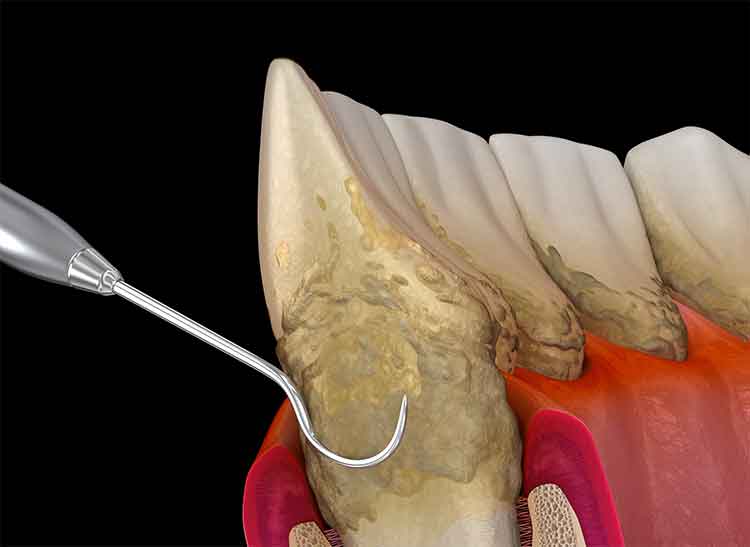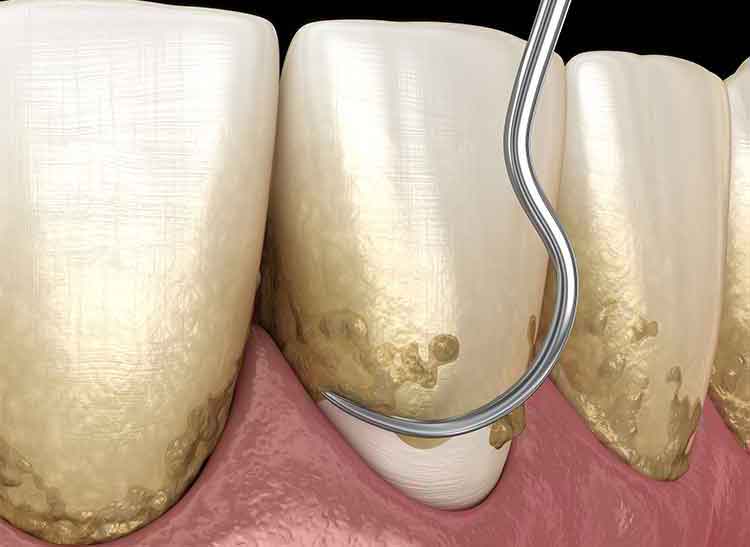Deep Cleaning Teeth With Scaling And Root Planing
If you have gum disease, the best way to treat periodontitis is to remove hard-to-reach tartar buildup through scaling and root planing. This procedure targets deep periodontal pockets to remove buildup below the gum line. Left untreated, gum pockets can deepen, lead to bone loss, and jeopardize the integrity of your tooth roots. Fortunately, root planing treatment can save your smile. By cleaning out your periodontal pockets, dental professionals can halt the development of periodontal disease (gum disease.) And your oral health won’t be the only thing that benefits. Your overall general health will be impacted as well.
Why Is Root Planing And Scaling Performed?
There’s more to your smile than what you see above the gum line. Scaling and root planing is a special type of “deep cleaning” that is needed for people with active gum disease. Although gingivitis can be reversed with good oral hygiene, periodontitis cannot. You might have undiagnosed chronic periodontitis if you show symptoms or warning signs like:
- Active inflammation
- Loose teeth
- Tooth sensitivity because of exposed roots
- Receding gum tissue
- Tartar across tooth surfaces
- Bad breath
- It’s been years since you’ve had your teeth cleaned
- Painful gums or teeth
- Spaces or food packing between teeth
Ultimately prescribing a treatment like scaling or root planing for our patients targets the bacteria causing the infection: plaque and tartar below your gums. If it isn’t removed in a timely manner, gum disease will progress until it leads to tooth loss. The American Dental Association also wants patients to know that unhealthy gum tissue is linked to overall health concerns. Unless root planing treatment is performed in a timely manner, your overall health can suffer as a result of chronic gum disease.


The Scaling and Root Planing Procedure
Gum disease treatment like scaling and root planing is more of an “in-depth” deep cleaning and teeth scaling. During the deep scaling procedure, each of the patient’s teeth is thoroughly cleaned of all soft and hard tartar buildup. More specifically, the tooth roots underneath the gumlines. A deep scaling usually involves numbing medication to ensure your comfort, with upper and lower quadrants of that side of the mouth being treated. You would then return for a deep scaling on the other side of your mouth at a separate appointment.
As a non-surgical gum disease treatment, scaling and root planing is typically preferred as the first step in managing active periodontal disease. By completing gum disease treatment early, we can delay the spread of oral bacteria to other parts of the body.
Your scaling and root planing appointments will usually last anywhere from 1-1.5 hours each. If you require sedation, the procedure length may vary.
Who Performs Scaling And Root Planing?
Our periodontal health procedures such as teeth scaling and root planing are completed by a registered dental hygienist. Hygienists are licensed dental providers that are similar to an equivalent of a registered nurse. They have extensive training and skill set in managing periodontal disease in addition to providing oral health counseling, preventative care, and screening for early-stage gum disease. Hygienists are also licensed to administer local anesthesia in a dentist’s office.
Tell Me The Difference Between Root Planing And Scaling?
Root planing and deep scaling go hand in hand when it comes to removing plaque, cleaning teeth roots, and helping gums reattach by establishing a clean environment. You cannot perform one without the other. The best way to understand the difference is by comparing a deep cleaning to regular cleanings, which are more preventative in nature. Whereas scaling and root planing is a procedure that targets deep infection surrounding the root surfaces. It is a “must-have” treatment for stabilizing oral health when a patient’s gums are severely infected or show signs of bone loss.
Is Scaling And Root Planing The Same As Deep Cleaning?
Yes. Deep cleaning is also referred to as scaling and root planing or an SRP/SCRP. The process of removing buildup from the surfaces of the roots–in the presence of deep periodontal pockets–requires more than a regular preventative cleaning. But depending on who you ask, non-surgical periodontal therapies such as scaling and root planing are often referred to as a deep cleaning. Regardless of the name, these procedures aim to remove plaque and bacteria that cause gum detachment and bone loss around teeth.
How Long Does It Take For Gums To Heal After Scaling And Root Planing?
You may be sore for a few days after a deep cleaning. Mostly because of sore gums, sensitive teeth roots, or where the injection was administered. To control pain or discomfort, rinse with warm salt water every few hours and take Motrin (ibuprofen) as directed. If for any reason you experience teeth pain beyond that, a periodontal specialist like Dr. Aalam or Dr. Krivitsky, or a general dentist may recommend a desensitizing treatment.
How Successful Is Scaling And Root Planing?
Teeth scaling and root planning are considered the standard treatment for moderate to chronic periodontal disease. This non-surgical intervention helps to improve the pocket depth around teeth and under the gums, reducing the risk of more bacteria or buildup contributing to bone loss. Without subgingival scaling, patients face the inevitable: gradual tooth loss or therapeutic extractions, which can lead to requiring dentures or dental implants.
Does Deep Scaling And Root Planing Hurt?
Since local anesthetic numbs your gums, it’s possible to clean throughout your mouth without causing major sensitivity or irritation. You can think of it like a traditional dental cleaning but on steroids. So, if you tend to have sensitive teeth, be sure to let us know. Additional comfort measures are available as needed.
Aftercare And Recovery
For the first few days after scaling, you may experience sore gums or mild bleeding. But by the time of your follow up visit, there should be a significant improvement in inflammation, redness, and bleeding. Not to mention reduction of gum pockets around some teeth. Periodontal disease is not a “reversible” condition, so you will need a regular follow up appointment every 3-4 months or so.
If you suspect that you have infected gums or you want a second opinion, contact our Los Angeles gum specialists today.
You May Also Like...
Understanding the Microbiome of the Mouth: Why Balance Matters for Gum Health
We often think of brushing, flossing, and regular cleanings as the cornerstones of oral health. But beneath these...
The Real Cure for Periodontitis: Dispelling Myths About Gum Disease Treatment
Periodontitis, commonly known as gum disease, has long been regarded as a chronic condition that can only be managed,...
Understanding TMJ Jaw Pain and Seeking Specialist Help
Navigating the complexities of jaw pain requires a deep dive into the various causes and conditions that lead...



